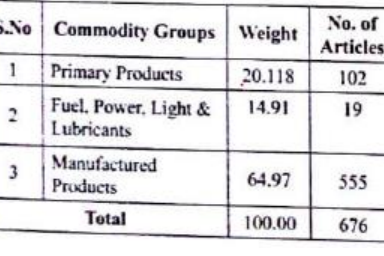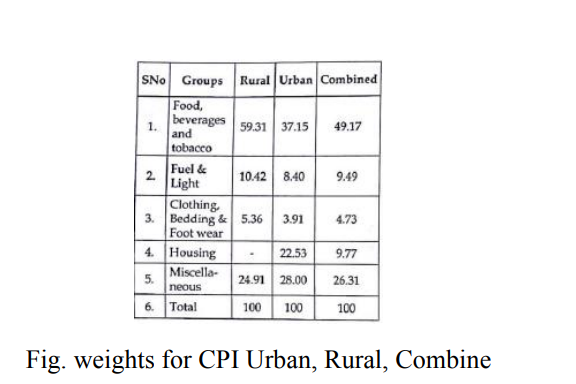INFLATION
- Definition: Persistent rise in the price of goods and services (G&S).
Types of Inflation:
- Creeping Inflation: General price increase up to 4% a year; considered a welcome inflation.
- Trotting or Walking Inflation: Price increase by a few hundred basis points beyond creeping inflation.
- Galloping Inflation: Price increase at 8-10% annually.
- Runaway Inflation: Rapid and uncontrollable price rise.
- Hyperinflation: Monthly price increase of 20-30%, with no tendency toward equilibrium.
Other Concepts:
- Deflation: Fall in prices; can lead to a self-reinforcing deflationary spiral if unchecked, requiring Keynesian stimulus.
- Disinflation: Reduced rate of inflation.
- Stagflation: Combination of inflation and unemployment.
- Reflation: Deliberate government action to stimulate the economy, often when inflation returns after deflation and recession.
- Skewflation: Price rise of a small group of commodities over a sustained period.
- Headline Inflation:
- Measured using the Consumer Price Index (CPI).
- Reflects inflation experienced by consumers and includes primary, fuel, and manufacturing inflation.
- Core or Underlying Inflation:
- Excludes transitory effects to focus on demand-side factors.
- Excludes food, fuel, and food processing manufacturing.
RECESSION
- Definition: Decline in macroeconomic indicators with rising unemployment.
- Technical Definition: Negative growth rate for two consecutive quarters.
- Double-Dip Recession: A recession followed by a short recovery, then another recession.
DEPRESSION
- Definition: An extreme form of recession.
- Characteristics:
- Prolonged duration.
- High unemployment.
- Credit unavailability.
- Shrinking output.
- Bankruptcies.
- Reduced trade volume.
- High currency volatility.
Types of Inflation Based on Causes
- Demand-Pull Inflation: Occurs when demand outpaces supply or there’s an inverse relationship between the two.
- Cost-Push Inflation: Results from supply shocks, such as increased input costs.
- Structural Inflation: Arises from deficiencies in the economy, like backward agriculture or inefficient distribution.
- Cartelization: Producers collude to push prices up.
- Hoarding: Accumulation of large quantities of goods.
- Imported Inflation: High import prices due to overdependency on imports.
Impact of High Inflation
- Investment:
- Short Run: Boosts investment due to:
- High inflation → High demand → Entrepreneurs expand production levels.
- Higher inflation reduces the real cost of loans, encouraging borrowing.
- Savings:
- Short Run: Savings may increase.
- Long Run: Savings decrease as inflation erodes purchasing power.
- Bracket Creep:
- Nominal value of gross tax revenue increases as taxpayers move into higher tax brackets without real income growth.
- Exchange Rates:
- Inflation often leads to currency depreciation.
- Trade Balance:
- Developed Economies: Inflation may improve the trade balance.
- Developing Economies: Inflation worsens the trade balance due to the composition of foreign trade.
- Employment:
- Short Run: Employment rises as demand increases.
- Long Run: Employment may decrease or become neutral.
- Wages:
- Nominal Wages: Increase.
- Real Wages: Fall, negatively affecting purchasing power and living standards.
- Banking System:
- Faces pressure from higher lending.
- Banks often do not revise nominal interest rates quickly, as the real cost of borrowing (Nominal Interest – Inflation) falls.
- Notes:
- Nominal Interest Rate: Actual price paid by borrowers to lenders, not adjusted for inflation.
- Real Interest Rate: Adjusted for inflation (Nominal Interest – Inflation).
Gainers vs. Losers During High Inflation
| Gainers | Losers |
|---|---|
| Debtors | Creditors |
| Producers | Consumers |
| Flexible income groups | Fixed income groups |
| Bond issuers | Bond holders |
| Debenture holders or savers with fixed interest rates (gain only if interest > inflation). |
Monetary Policy Framework Agreement (2015)
- RBI targets CPI (Combined) inflation within 4% ± 2%.
- Inflation targeting:
- Government of India (GoI) sets the inflation target in consultation with RBI.
- RBI is responsible for achieving the target.
Urjit Patel Committee Recommendations (2014)
- Set the inflation target at 4% ± 2%.
- Define the nominal anchor in terms of Headline CPI.
- Ensure fiscal deficit is reduced to 3% by 2016-17.
- Establish the Monetary Policy Committee (MPC) for decision-making.
- RBI to independently fix the inflation target.
Monetary Policy Committee (MPC)
- Introduced under the Monetary Policy Framework Agreement (2015).
- Finance Act 2016: Amended the RBI Act, 1934, providing statutory backing to the MPC.
- Composition:
- Governor of RBI (Chairperson).
- Deputy Governor in charge of monetary policy.
- One RBI official.
- Three members nominated by the Central Government.
- Key Features:
- Members are not eligible for reappointment.
- Decisions are binding on RBI.
- Publishes a Monetary Policy Report every six months.
- Meets four times a year.
Indices for Calculation of Inflation
1. Wholesale Price Index (WPI)
- Definition: Measures inflation at the wholesale transaction level for the economy as a whole.
- Published By: Economic Advisor, DIPP, Ministry of Commerce, on a monthly basis with a one-month lag.
- Commodities Categories:
- Primary Articles
- Fuel and Power
- Manufactured Goods

- Limitations: Does not include services and the unorganized sector.
- New All-India WPI:
- Base Year: 2011-12.
- Excludes indirect taxes to eliminate the impact of fiscal policy, making it closer to the Producer Price Index (PPI) and reflecting production-side inflation.
- Introduced a separate WPI Food Index, combining food articles under primary articles and food products under manufactured products.
2. Producer Price Index (PPI)
- Definition: Measures the price received by producers for their goods.
- Development:
- 2014: Goldar Committee set up to develop PPI.
- 2019: Government commission established to transition from WPI to PPI as the deflator in GVA/GDP calculations.
3. Consumer Price Index (CPI)
- Definition: Tracks changes in the price of a basket of goods and services purchased by households.
- Published By:
- Ministry of Labour: CPI for Industrial Workers (IW) and Rural Labourers (RL).
- CSO: CPI (Urban, Rural, Combined).
- base year 2012
- Components: Consumer Price Index has 6 main components with differing weights
- Food and beverages (45% weight overall with Cereals accounting for 9.67% of the total)
- Pan, tobacco, and intoxicants (2.38%)
- Clothing and footwear(6.53%)
- Housing (10.07%)
- Fuel and light (6.84%)
- Miscellaneous (services such as education, health care etc.) (28.32%)

4. Consumer Food Price Index (CFPI)
- Definition: Measures changes in the retail prices of food products.
- Introduced By: CSO at the all-India level in 2014.
5. Services and Price Index (SPI)
- Committee: Established by DIPP on the advice of C.P. Chandrashekhar.
6. Housing Price Index (HPI)
- Published By: RBI.
- Frequency: Quarterly.
- Coverage: Tracks housing price changes across 10 major cities.
7. Index of Industrial Production (IIP)
- Definition: Measures industrial growth and assists in estimating GDP growth.
- Industry Classification:
- Manufacturing (77%).
- Mining (14%).
- Electricity (7%).
- Published By: CSO on a monthly basis.
8. Purchasing Manager’s Index (PMI)
- Definition: Predicts levels of industrial production in advance, covering both manufacturing and services.
- Published By: HSBC and Markit (Nikkei).
- Interpretation:
- Above 50: Expansion in industrial production.
- Below 50: Contraction in industrial production.